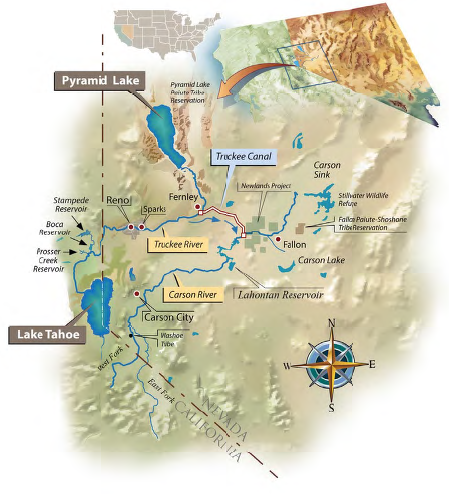Project Overview
Water for the Seasons partners scientists with community stakeholders in the Truckee-Carson River System to explore new strategies and solutions for dealing with extreme climate events, such as droughts and floods. Funded by a grant from the National Science Foundation and the U.S. Department of Agriculture, this four-year research and outreach program uses a collaborative modeling methodology which strategically links scientific research with community problem-solving. The goal of this program is to assess and enhance community climate resiliency, or ability to adapt to extreme climatic conditions, in snow-fed arid land river systems.
Truckee-Carson River System
The Truckee-Carson River System originates in the Sierra Nevada, and relies on winter snowpack and spring runoff as the primary sources of water (see Figure 1). The system provides water for municipalities, agriculture, industry, recreation, tourism, fisheries and wildlife habitat.
In snow-fed arid-land river systems, such as the Truckee-Carson River System, the duration and timing of storms and runoff are critical factors that determine quality of life, making these communities particularly vulnerable to complex and unexpected drought and flood events.
The Truckee-Carson River System was selected for this pilot study because it is a prime example of a snow-fed arid-land river system, which within a relatively small geographic area encompasses many of the major water management challenges common to communities in the American West.
What is a Climate-Resilient Community?
In the Southwestern U.S., climate change has already been linked to heat waves, drought and wildfires. Predictions for the future include declining water supplies, reduced agricultural yields, human health impacts and changes to snowpack (Garfin et al., 2014).

Figure 1. Map of the Truckee-Carson River System.
A climate-resilient community is one that has developed the capacity to adapt or respond effectively to change in the face of extreme climate events. Its stakeholders understand, acknowledge, anticipate and absorb extreme climate events, and possess the capacity to reorganize as necessary to maintain essential community functions and identity (Moench, 2014).
Who is Involved?
Researchers from the University of Nevada, Reno, the Desert Research Institute, U.S. Geological Survey and Ohio University work with a Stakeholder Affiliate Group to guide research activities during the four years of this program.
Stakeholder involvement in the program is especially important, and improves the practicality and usefulness of the research (Bergold & Thomas, 2012). The diversity of the Stakeholder Affiliate Group is important to the integrity of the research, as climate change and extreme climate events are likely to affect each group differently.
Program Goals
Water for the Seasons creates a framework for engaging diverse stakeholder communities in the effort to improve water sustainability and climate resiliency in the Truckee-Carson River System. The program does not aim to resolve historical water allocation disputes, but to enhance knowledge for water managers and water right holders to adapt to a changing climate. The result is an integrated suite of models that can be used for planning purposes by water managers, agricultural producers and municipalities in the Truckee-Carson River System.
Program goals include:
- Use stakeholder knowledge to define extreme climate scenarios that impact water supply and demand.
- Model water supply and demand outcomes that result from these climate scenarios.
- Integrate human decision-making with hydroclimatic models to understand water sustainability and climate resiliency.
- Assess the transferability of the Truckee-Carson River System models to snow-fed arid land systems globally.
Developing a Collaborative Model
The program works with the Stakeholder Affiliate Group to examine the resiliency of natural and built environments in the Truckee-Carson River System under extreme climate scenarios and land use changes. Interviews with stakeholders provide diverse perspectives and historical knowledge about droughts, floods and other extreme climate events.
A suite of models integrates:
- Surface and groundwater data, evapotranspiration rates and climate variables.
- Reservoir storage and water release options.
- Water-use priorities under different climate scenarios.
By using an iterative process for broad stakeholder engagement, the program integrates human decision-making with hydrology and climate models that encourage communities to adapt to climate change.
Desired Outcomes
The program’s stakeholders have listed the following desired outcomes:
Resiliency Planning Outcomes:
- Resiliency Planning OutcomesGenerate climate change options and information to help decision-makers better manage water resources during extreme climate events.
- Improve efficiency of water rights transfers on individual farmers’ lands to better use scarce water supplies.
Climate Adaptation Outcomes:
- Evaluate climate change impacts on the river system and surrounding communities.
- Produce information to help with climate adaptation strategies.
- Develop groundwater projections and estimate water balances for the region.
- Provide “big picture” supply-demand scenarios under different climate change scenarios.
Decision-making Process Outcomes:
- Develop a regional stakeholder group, and increase collaboration and communication among stakeholders.
- Educate the public and stimulate public discussion.
Want to Know More?
Program updates and information are available via Water for the Seasons program page and Cooperative Extension’s Living With Drought website: Living with Drought.
References
Bergold, J. & Thomas, S. (2012). Participatory research methods: A methodological approach in Motion. Focus: Qualitative Social Research. Vol.13 (1).
Garfin, G., G. Franco, H. Blanco, A. Comrie, P. Gonzalez, T. Piechota, R. Smyth, and R. Waskom, 2014: Ch. 20: Southwest. Climate Change Impacts in the United States: The Third National Climate Assessment, J. M. Melillo, Terese (T.C.) Richmond, and G. W. Yohe, Eds., U.S. Global Change Research Program, 462- 486. doi:10.7930/J08G8HMN. Available: Southwest
Moench, M. (2014). Experiences applying the climate resilience framework: linking theory with practice. Development in Practice, 24(4), 447-464.
McCarthy, M., Singletary, L., Sterle, K., Simpson K., Fitzgerald, K., Pohll, G., Rajagopal S., Huntington, J., Dettinger M., Niswonger, R., and Kauneckis, D.
2016,
Sustaining Water and Climate Resiliency in the Truckee-Carson River system,
Extension | University of Nevada, Reno, Fact Sheet FS-16-01


